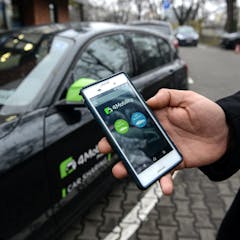
Articles on Mass transit
Displaying 1 - 20 of 26 articles

Love it or hate it, the ‘Acela Corridor’ has developed a widely recognized identity thanks to the trains that link it together.

Post-pandemic pressures are compounding stresses cities were already facing, leading to the hollowing out of some American cities.

Traffic crashes kill and injure millions worldwide every year and are a major drain on economic development. Improving road safety would produce huge payoffs, especially in lower-income countries.

A global study of 117 cities finds Australian capitals have fairly poor access by car. Public transport, cycling and walking access is better than in the US, but not as good as in Europe and China.

Transit agencies could use the money to buy new subway cars, buses and maintain rails. The funding is designed to build on last year’s emergency aid, which kept transit operating through the pandemic.

In many cities contemplating new light rail systems, bus rapid transit offers a cheaper, faster and more flexible solution.

Coronavirus has changed population projections and behaviours across society. With fewer commuters we need to shift transport planning based on a hub-and-spoke network to focus on more local travel.

Car use and cycling have soared to above pre-pandemic levels in our biggest cities (Melbourne is an obvious exception). Walking is not far behind, but public transport is being shunned.

As COVID-19 restrictions are eased, cities face crippling congestion if people shun crowded public transport. More frequent and faster services, using innovations like pop-up bus lanes, can avoid this.

One in 5 of the poorest US households don’t have a car and rely on public transportation to get around.

On-demand public transport has now provided over 1 million rides in 36 trials in various Australian cities. Is the problem of poor suburban public transport on the way to being solved?

Starting in 2021, drivers will pay a fee to enter midtown and lower Manhattan during busy times of day. Will this clear New York’s air and streets?

This attention grabbing policy has less to do with solving public transport problems, and more to do with the government’s nation-branding campaign.

Under 10 percent of new Citi Bike and Divvy bike docks are sited where residents suggested using interactive online maps, a new study shows. But that doesn’t mean city officials weren’t listening.

Rising e-commerce means more delivery trucks and urban gridlock. Lockers at transit centers, where carriers can leave packages for people who live or work nearby, are a potential solution.

The autonomous rail rapid transit (ART) system developed in China might make buses sexy, but the technology alone won’t resolve the issues of road space and right of way in Australia.

Investment is pouring into urban technology, much of it into innovative ventures that aim to transform how we get around our cities.

For 40 years the author has argued that trains and trams are better than buses. New ‘trackless trams’, which take innovations from high speed rail and put them in a bus, have changed his mind.

A dormant ‘cash mountain’ marks a nadir for London’s contactless travel card, but trouble has been brewing for some time.

Cities are expanding upwards and downwards, as well as outwards. With urban density also increasing, moving people efficiently around the city, often using ageing infrastructure, is quite a challenge.
